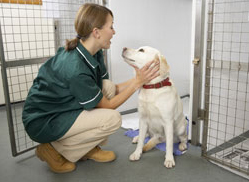
Pets feel pain. Sometimes this is quite clear to see, like when a dog’s toe is accidentally stepped on followed by a heartbreaking yelp, or when a cat that has been in a fight hisses at the vet trying to examine his wounds!
When it comes to chronic pain, however, the signs our pets show can be a lot more subtle. Here a few myths we thought we’d share:
1) MTYH: My senior pet is reluctant to go on walks and is moving around slowly, but this is normal because of ‘old age’:
- FACT: Age isn’t a disease! Senior pets that are ‘slower’ are often suffering from arthritic pain or other illness(es). Sure, pets age just like we do. But dogs and cats are different from people in that they don’t know they are old. They stay young at heart, and given the chance would walk and play with their human companions throughout their lives. So when older dogs and cats show a change in their activities, pet owners and veterinarians should take notice. After a thorough examination (perhaps along with select diagnostic testing), your veterinarian may prescribe pain medications and/or nutritional supplements that can help pets with arthritis or other painful conditions move more smoothly and comfortably.
2) MYTH: My pet’s teeth can’t be painful, because he is still eating hard food
- FACT: If pets are hungry, they will eat. Even if the process of chewing causes pain, a pet’s hunger will override their desire to avoid pain. We know that pets with periodontal disease, cavity lesions, broken teeth, and tooth root infections feel pain just like we do. In fact, we will often see a positive change in a pet’s mood and energy after a dentistry is completed and oral problems have been addressed. This is because chronic pain has been relieved.
3) MYTH: My pet isn’t crying or complaining, therefore she isn’t in pain
- FACT: Pet’s naturally don’t like to make it obvious that they are in pain. Pets that have pain rarely cry out, because in nature this would make them a target for predators. Instead, pets show their pain through their behaviour. They may eat less, interact less with family, decrease their activity, or hide. For more information on what a pet in pain might look like, check out these pain scales prepared by the Colorado State University:
These are used by veterinarians to assess whether an animal is in pain (for example, after a surgery). They can also be used to observe pets at home for the subtle signs of pain.
For a more extensive list of signs to look out for, click this link
4) MYTH: Pain medications will make my pet tired
- FACT: In most cases, pets tolerate pain medication very well. Your veterinarian will carefully select the pain medication that bust suits your pet’s needs and will review potential side effects to watch for. While some pain medications may have mild sedating effects, these usually abate over time. For the most part, pain medications are used safely for long periods of time and allow pets to be MORE active and energetic because they are feeling better!
Is your pet showing signs of pain? We can help! Please schedule an appointment today and we will gladly review a plan for you and your pet.



